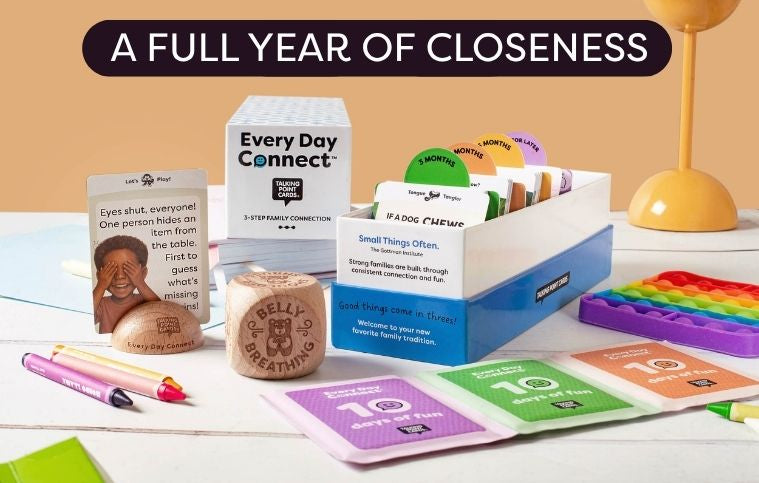SHOP
About

10 Family Card Games for the Perfect Game Night
January 03, 2025 9 min read
Family game nights are a magical way to turn an ordinary evening into a memorable time spent with the family.
There are many game options to bring out on family game night, and card games are popular.
Family card games draw (no pun intended) everyone together, from children to grandparents, and bolster an enjoyable night spent with family.
With just one deck of cards, you can host various family card games and tailor them to your family’s size, age, and interests.
With so many options, what game should you play at your next family game night? Here are our top 10 family card games you can play at your next family game night.
Check out our line of custom-playing cards
Crazy Eights
Crazy Eights is a fast-paced but straightforward card game that’s fun for all ages, making it the perfect family card game. The object is to be the first player to eliminate all your cards.
Here’s how to play:
-
Each player is dealt five cards, and the rest of the deck forms the draw pile. The top card is flipped over to start the discard pile.
-
On your turn, you must match the top card of the discard pile by either suit or rank. You draw from the draw pile if you can’t play a card.
-
Eights are a wild card and can be played at any time, allowing a player to declare the next suit to be played.
-
The game continues until one player plays their last card.
-
Play by game or by score! To play by score, tally up the values of cards remaining in each player’s hands, with the lowest scorer after multiple rounds wins. (face cards = 10 points, eights = 50 points, and others are face value)
War
War is a two-player card game perfect for anyone who enjoys a bit of luck-based competition. Since it’s only two players, you can make a tournament-style bracket to involve this in the family game night. The goal is to win all the cards by competing in “battles.” ‘
Here’s how to play:
-
Start by shuffling the deck and dealing with all the cards evenly between each player’s face down.
-
Without looking, each player flips over the top card of their deck at the same time. The player with the higher card wins both cards and adds them to the bottom of their deck.
-
If the cards are of equal rank, a “war” occurs where each player places three cards face down and then flips a fourth. The higher fourth card wins all the cards that were involved.
-
The game ends when one player wins all the cards or players agree to stop after a set time.
Go Fish
Fish is a classic family card game. It’s a fun and easy card game for families and younger children. The goal is to collect the most sets of four cards of the same rank.
Here’s how to play.
-
Each player is dealt five cards; the remaining cards form the draw pile.
-
On your turn, ask another player for a specific rank that you think they have in their hand: “Do you have any threes?” If they have a card of that rank, that plate must hand them over to you, allowing you to continue your turn. If not, the asker says, “Go Fish,” and draws a card from the draw pile.
-
If the drawn card matches your requested rank, you get another turn; otherwise, the turn moves to the next person.
-
A set of four matching cards is placed face up, and the game ends when all sets are made or the draw pile is empty. The player with the most sets wins!
Hearts
Hearts is a trick-taking card game where players try to avoid collecting penalty points. Although the game can be more complicated, it is still an enjoyable family card game with a twist.
Here’s how to play:
-
The game is played over multiple rounds. Players aim to score lowest when a set limit (usually 100 points) is reached.
-
The Queen of Spades is worth 13 points, and each heart card is worth 1 point. Each player is dealt 13 cards, and before the round starts, players pass three cards to opponents (the passing directions alternates: left, right, across, or no pass).
-
The player holding the 2 Clubs leads the first trick. If possible, players must follow suit; if not, they can play any card, including hearts or the Queen of Spades, after hearts have been“broken” (a heart is played in a previous trick).
-
The highest card of the suit wins the trick. The game ends when one player reaches or exceeds the point limit, and the player with the lowest score wins.
Spades
Spades are similar to Hearts; it’s a strategic trick-taking card game, ideally for four players in fixed partnerships where partners sit opposite each other. The goal is to bid and win the number of tricks accurately your team predicts while avoiding penalties.
Here’s how to play:
-
Using a standard 52-card deck, players are dealt 13 cards each.
-
Starting with the dealer’s left, players bid the number of tricks they think they can win with both partner’s combined cards.
-
The player to the dealer’s left leads the first trick, and the next player must follow suit if possible, where the highest card of the suit wins unless a spade is played (spades act as a trump card).
-
Spades cannot be led until broken (played during a trick of a different suit).
-
Teams score 10 points per trick bid and 1 point for each trick they bid over. Failing to meet the bid results in a penalty of 10 points per trick bid.
-
The game typically ends when a team reaches a set score, such as 500 points.
Spoons
Spoons are the perfect family card game for those who like to test their quick reflexes, and yes, spoons are involved. The goal is to collect four cards and grab a spoon from the center before your opponent does.
Here’s how to play:
-
To set up, place one fewer spoon than the number of players in the center of your playing area and shuffle a standard deck of cards.
-
Each player is dealt four cards, and the dealer draws a card from the deck, deciding whether to keep it or pass it to the next player, and discards one card to their neighbor.
-
Players continue passing cards around the table while trying to collect a set of four cards. Once players collect a set of the same rank, they silently grab a spoon, prompting others to do it.
-
The player left without a spoon receives a letter in the word “SPOON.” When all letters are received, the player is eliminated, and the game continues until only one player remains.
Slap Jack
Slap Jack is a lively and straightforward card game that tests everyone’s speed and reflexes, making it perfect for family game night. The goal is to win all the cards by being the first to slap the pile whenever a Jack is played.
Here’s how to play:
-
To Begin, the deck is shuffled and dealt face-down evenly to all players.
-
Players take turns flipping the top card of their pile face up onto a stack in the middle of everyone.
-
When a jack is drawn, players race to slap the stack. The first player to slap it wins the entire pile and adds it to the bottom of their deck.
-
If a player slaps the incorrect card, they must give one card to the player who last flipped the center deck.
-
Players are eliminated when they run out of cards but can still slap the deck to re-enter the game if they win the pile.
-
The game ends when one player controls the entire deck.
Speed
Speed is a fast-paced card game where quick thinking and rapid reactions are key. It’s only two-player, so you must make a bracket or take turns during family game night. The goal is to be the first player to get rid of all your cards by playing them in ascending or descending order onto two piles in the middle.
Here’s how to play:
-
Each player is dealt 20 cards to their draw pile, five cards to their complex, and 15 cards set to a side pile.
-
Two stacks are placed in the middle with one face-down card each, and five “stock” cards are placed focused down in the middle to replenish play.
-
When the game starts, players flip the two center cards face up simultaneously and race to play cards from their hands onto either pile.
-
You match the top card by rank by being high or lower. Players draw from their side pile to maintain five cards in their hand throughout the game. If both players are stuck, they flip a new stock card onto the center piles and resume.
-
The first player to use all their cards wins.
-
The game ends with a tie if no player can continue and the stockpile is empty.
Thirteen
Thirteen, also known as Chinese poker, is a competitive and strategic card game. To win, you play cards in specific combinations. The goal is to be the first to eliminate all your cards.
Here’s how to play:
-
Using a standard 52-card deck, each player is dealt 13 cards.
-
The player with the 3 of Spades starts by playing a single card, pair, or combination of cards (straights, whole house, etc).
-
Subsequent players must play higher-ranking cards of the same type or pass. Play continues around the table until no one can or wants to play higher; at this point, the pile resets, and the last player to play leads the next round.
-
Unique combinations, like four-of-a-kind, can clear the pile immediately.
-
The game ends when one player runs out of cards, and the others are ranked based on the number of cards left. Multiple rounds can be played for an overall winner.
Rummy
Rummy is a classic card game that focuses on forming sets and runs to score points. It’s a great family card game for game night. The goal is to be the first to play all your cards by creating valid combinations.
Here’s how to play:
-
Using a standard 52-card deck, each player is dealt seven cards. The remaining cards form a draw pile, with the top card face-up as the discard pile.
-
Draw a card from either pile on your turn, then discard one. Players can lay down combinations or add to an existing one.
-
A set is three or four cards of the same rank, and a run is three or more consecutive cards of the same suit.
-
The round ends when a player has no cards left or the draw pile is empty.
-
Points are calculated based on cards in the opponent’s hand (face cards = 10 points, aces = 1 point, others = face value).
-
The game continues over several rounds, with the winner being the player who reaches a predetermined score, such as 100 points.
Get one-of-a-kind playing cards for your game nights
Talking Point Cards
Talking Point Cards is an interactive game that encourages family bonding and conversation. It’s a great family card game for game night, and there is no scoring - everyone is a winner. The goal is to learn more about each other and encourage conversation.
Here’s how to play:
-
The first player draws from one of 200 prompts crafted by communication experts. These prompts allow you to open up the floor for family-based conversations. There are four categories: Get to Know You, Family Time, What Makes You, You, and Fun and Random.
-
The first player reads the question aloud. We recommend taking turns and asking each person the same prompt for the best results.
-
The children answer first, then the parents. This ensures that the children respond more freely and won’t feel restricted or guided by previous answers.
-
Continuing drawing cards and taking turns.
-
The game continues for several rounds until the group feels more connected or the conversation continues. There’s no official ending—just meaningful connections, laughter, or heartfelt moments!
Talking Point Cards provides a variety of family conversation card games that bring out the untold stories you’ve always wanted to hear.
Each pack contains 200 prompts that communication experts have expertly crafted, allowing you to open up the floor for family-based conversations safely.
Talking Point Cards differ from your typical family card game because it focuses on establishing communication lines for everyone in your family and creating foundations for genuine family connection.
If you’re looking to get more out of the family game night, Talking Point Cards Family Pack is the perfect addition to bring your family closer than ever.
Talking Point Cards Family Packs
About Talking Point Cards
It all started in the leafy bushland of Sydney, Australia, in 2015. Following his goal of helping people connect, founder Ben Jones designed beautiful playing cards to encourage face-to-face interaction through fun games. What began as a simple idea fuelled the desire to do more.
As Ben connected with friends, family, and colleagues, he kept hearing the same thing: people were exhausted from constant online engagement and craved deeper connections away from the digital world.
Wanting to offer a solution, Ben collaborated with expert teachers and psychologists worldwide to create our first set of conversation starter cards.
It’s simple: Talking Point Cards are fun, engaging, and highly effective conversation tools. Global experts have developed and reviewed our products (67 so far).
They are deceptively easy to use: Start a fun routine of pulling a card and asking questions. And they work (1 million customers, 10,000+ reviews)!
Get Talking Point Cards today and start the conversation!










